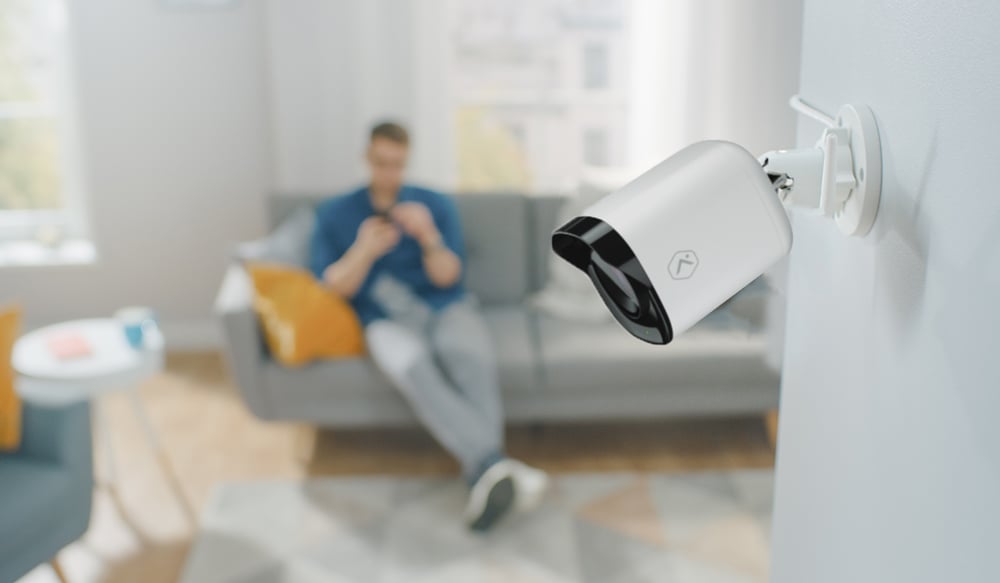Benefits of Smart Home Security Cameras
Security Cameras Security Systems Smart Homes Sep 2, 2022 9:32:30 AM General Security 5 min read

As more and more Americans seek to safeguard their families and homes, security cameras with smart technologies can be the difference between thefts, injuries, and other hazards. According to the National Council for Home Safety and Security, unprotected homes are 300 percent more likely to experience break-ins and burglaries.
While indoor/outdoor and doorbell cameras help combat burglaries, adding smart home security system components with 24/7 protection are gaining ground for optimal protection. According to a 2020 report by business consulting firm Grandview Research, the global smart home security camera market will increase 18.7 percent by 2030.
Smart security cameras provide added peace of mind, whether you’re home or away.
Let’s examine this technology’s best features, as well as optimal placement, models, smart home integrations, and more.
Smart Security Camera Features & Benefits
Security is top priority among all homeowners, and especially those with children, teens, elderly loved ones, and even household pets.
Effective safeguards include strategically placed indoor, outdoor, or doorbell cameras with smart capabilities. These help alleviate stress and instill much-needed peace of mind. Imagine visually inspecting outdoor areas following harsh weather, or ensuring loved ones are safe and sound in real time from the convenience of any mobile device, regardless of your location!
Utilize the Alarm.com mobile app for critical check-ins on loved ones when you’re away, and set up alerts to help ensure important activities are adhered to, such as sleeping, eating, and medication schedules for seniors. The same applies to children arriving home from school, or teens subject to curfews.
Visible smart security cameras can often deter criminal activities, such as burglaries, theft, and vandalism. They can also assist law enforcement in identifying—and even apprehending—suspected perpetrators through cloud-based images and video stored within network video recorders (NVR).
Integrating security cameras within your smart home security system can also result in discounts on homeowners’ insurance policies. It’s best to speak with your provider for more information and exact amounts.
According to the National Council for Home Safety and Security, unprotected homes are 300 percent more likely to experience break-ins and burglaries.
Best Security Camera Placement & Types
Consult a reputable provider such as General Security for optimal camera placement and installation. While you could choose a do-it-yourself (DIY) method, a trusted, knowledgeable advisor is worth his or her weight in gold. Regardless of model, cameras should always be positioned between eight and 10 feet from the ground.
Indoor Cameras
Place indoor cameras in hallways and front-door areas to easily capture arrivals and departures. This helps ensure children adhere to bedtime and homework/study schedules. Should trespassers gain entry, indoor cameras can also record intruders and any stolen property.
Outdoor Cameras
These boost security around pools, grills and patios, and other surrounding areas with up-to-the-moment alerts, regardless of your location. Consider running wires within outdoor soffits where they can’t easily be spotted, cut, damaged, and disabled. Alternatively, install wireless cameras.
Wellcam
Available through General Security’s vendor partner Alarm.com, this is especially helpful for seniors requiring adding care. Dubbed the “Smart Video Solution for Independent Living,” Wellcam boasts a 180-degree view field with 1080p resolution. Monitoring an entire space within the home, it also features directly connected, two-way audio and video, and emergency alerts.
Doorbell/Front Porch
Aside from keeping so-called “porch pirates” at bay, doorbell cameras provide contactless, two-way audio/video communication. You can remotely screen delivery personnel or other front-door guests from the Alarm.com app, even when you’re not home.
Smart Home Technology Integrations
Integrating cameras with smart technologies into your home security systems and protocols elevates protection to the next level. Here’s a useful breakdown of several advanced features:
Did You Know? Regardless of model, security cameras should always be positioned between 8 and 10 feet from the ground.
Real-Time Mobile Device Alerts
Smart security cameras feature 24/7 mobile device alerts for most activities within and around your home.
Motion Detection
This technology identifies and matches images with previously programmed settings via analysis differentiation—providing an extra layer of protection that can tell between humans and false alerts such as wildlife or passing vehicles. Activated by movement, it filters out irrelevant video while maintaining adequate memory and storage capacities.
Video Analytics
Analyzing and differentiating between animals, humans, and vehicles, video analytics can also be pre-programmed as virtual tripwires and customized geofencing boundaries. Security cameras compatible with Alarm.com Perimeter Guard greet trespassers with loud alarms and bright, red LED lights.
Remote Video Monitoring
Also known as video surveillance, this technology comprises closed-circuit television (CCTV)- or IP-based cameras, NVRs, and video management software (VMS) for easy viewing, recording, and playback.
Ensuring the Best Choice for Your Family & Home
Consult a reputable specialist, such as General Security, for recommendations on the best home security cameras and accompanying smart technologies.
General Security provides security cameras, video surveillance, and smart technology solutions to protect your loved ones and home. Request a free quote from us today!
